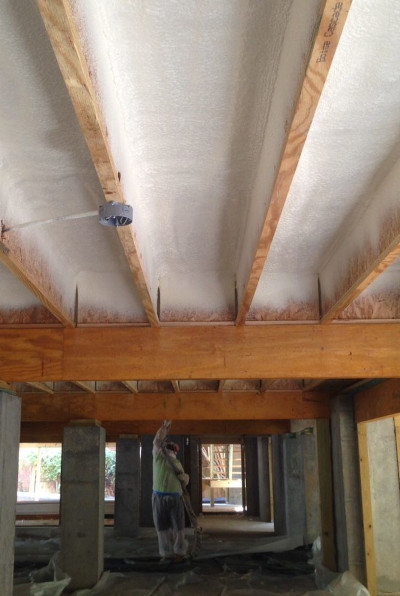
Whether you or a previous homeowner have added an addition to your home or it is part of the original foundation, you may have noticed that rooms above a crawlspace area tend to be colder in the winter time. This is because crawlspaces in older homes are often completely un-insulated, or even in newer construction they are designed as an “unconditioned” area of the house. Because they are often hard areas to access, crawl spaces are often missed when it comes to opportunities to improve the energy efficiency and comfort of your home.
The most common way that crawl spaces are insulated is with fiberglass batting which is installed on the ceiling of the crawlspace against the floor of the home. This is done to help stop the heat transfer from the home to the cold crawl space. The problem with this approach; however, is that very often the fiberglass batting does not have the appropriate support which will keep the batts from sagging or falling completely over time. If the fiberglass stops making contact with the floor above, it completely loses its effectiveness in stopping heat transfer between the cold crawl space and your home. Furthermore these types of crawl spaces are usually vented directly to the outside, allowing cold air to come directly into the crawl space. Even if the fiberglass batting is properly installed, it is not a form of insulation that is designed to stop air movement.
Other builders try to avoid this problem by insulating the walls of the crawl space. This avoids the problem of having the insulation fall down over time, but unless the contractor also installed an air barrier in front of the insulation, these crawl spaces usually still allow cold air infiltration that can move right into your living space. Oftentimes these crawl spaces will also have ductwork which delivers hot/cold air to the rooms above. If the ductwork is not perfectly sealed, or properly insulated, the conditioned air that you are paying to heat or cool the living space above may be going directly into or through the unconditioned crawl space.
Regardless of the type of crawl space you have, an important factor when evaluating your crawl space is whether or not it contributes to poor indoor air quality in your home. Because of their location at the foundation, crawl spaces often tend to be dirty wet areas, which can contribute to higher humidity or pollutants entering the home. Even in crawl spaces without standing water, the ground vapor from crawl spaces with dirt floors can add excess humidity to the home, and contribute to the possibility of mold/mildew buildup in the living space. Lastly, crawl spaces are the main location from which cancer causing gases such as radon may have a pathway to enter your living space.



There are two main approaches to insulating crawl spaces – to insulate the walls or to insulate the ceiling. Insulating the walls of the crawl space reduces radon gases, lowers humidity levels, eliminates musty odors, and reduces heating costs. Treating the ceiling of the crawl space will completely separate your home from that cold crawlspace air.
If your crawl space is well-connected to the rest of your home, the best solution would be to bring the crawl space into the conditioned space by air sealing and insulating the walls, installing a reinforced vapor barrier, and installing a ventilation system. Our process starts by removing and discarding the old, existing crawl space insulation. We will then lay a new, reinforced vapor barrier that will prevent humid air from entering the space. We finish by sealing all the exterior walls of the crawl space with a closed cell spray foam insulation from the ground to the top of the crawl space wall.
When treating the ceiling of the crawl space, the existing insulation will be removed and disposed of. Spray foam insulation will then be applied directly to the crawl space ceiling. If there are any walls of the crawl space that are against the basement, these walls will also be insulated to further isolate the crawl space from the living space of your home.
A two part closed cell foam is used in all crawl space applications which provides a moisture barrier on any location in which the foam is applied.
By choosing Atlas Home Energy for your home upgrades, we promise to:
Effective Date: 09/05/2023
This Privacy Policy explains how Atlas Home Energy Solutions collects, uses, and discloses personal information about our customers, prospective customers, and visitors to our website at www.atlashomeenergy.com.
Information collected directly from you: We may collect personal information directly from you, for example through a web form, while scheduling a service, when you contact us for customer support, or upon signing a contract for service. Personal information we collect directly from you may include first and last name, address, email address, and phone number.
Information collected from your device: Our website may use technologies such as cookies, web beacons, pixels, and other similar technologies to automatically collect certain information from your device including, for example, your IP address, date and time of your visit, browser and operating system information, referring website address, and other information about how you interact with the website. Our website may also use cookies and similar technologies to enhance your user experience and enable certain features. Our email campaigns may also use tracking technologies such as web beacons, pixels, and other similar technologies to automatically collect certain information such as IP address, browser type and version, and email engagement statistics.
Information collected from your partners: We may collect personal information about you from our third-party partners and combine it with other information that we collect. Personal information we collect from our partners may include, for example, your demographic information, shopping history, and geographic location.
Personal information collected from you may be used to contact you via SMS Text, Email, or Phone in order to: schedule you for an estimate or consultation, respond to customer service inquiries, complete home improvement services, confirm upcoming service appointments and to request feedback for services performed. At no time will your personal information be distributed or sold to third parties for marketing purposes.